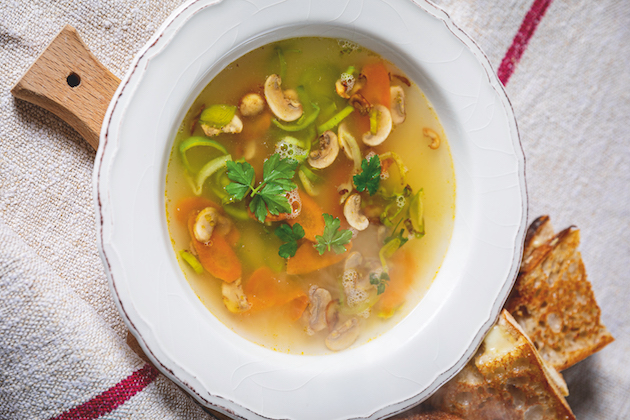Recipe for pheasant keema – perfect for feeding a large group of people
You may find, like I did, that this colourful spicy pheasant recipe fast becomes a household favourite. Once a kitchen…
Win CENS ProFlex DX5 earplugs worth £1,149 – enter here
 Rose Prince 000020 - Game Bone Broth with Toasted Barley, melted Ogleshield cheese croque. Finished Recipe.
Rose Prince 000020 - Game Bone Broth with Toasted Barley, melted Ogleshield cheese croque. Finished Recipe.
In my kitchen, making stock from leftover bones or carcases is part of an economic plan. It is a simple process that extracts a greater value from the bones of game birds, yielding a second meal. This pheasant stock recipe is wonderfully versatile, vital for creamy vegetable soups, making gravy or using in risotto or pilaf. But in its own right — as a clear, full-flavoured base for a variety of warming and healthy broths — it is elegant, however humble.
You must mine the maximum amount of flavour from the bones. Game birds do not yield as much ‘essence’ as chicken, so add good-quality low-salt or organic vegetable stock powder to the roasted bones. Make sure the carcases are clean, wiping away dried blood and removing bruised meat, both of which can make the stock bitter.
(You might also like to see this recipe for game stock.)
1. Preheat the oven to 180°C. Put the carcases in a roasting tin, pour over the olive oil and turn the bones in it so they are well covered.
2. Sprinkle over the milk powder —
this is a chef’s trick; the powder turns light brown during roasting
and adds colour to the stock.
3. Roast the bones for 30 to 40 minutes until golden then remove. Add a little oil to a large saucepan
with the carrot, leek, garlic, celery, juniper berries, peppercorns and
parsley and stir-fry over a low heat
for 2 minutes. Add the bones, cover with the vegetable stock then simmer for an hour.
4.Strain the broth through a sieve, discarding the bones, and season with sea salt to taste. It is important that the flavour of the stock is satisfyingly powerful.
This is the broth for winter ‘light diet’ days; sustaining yet very clean. Add a little olive oil to a saucepan with thinly sliced leek, button mushrooms and carrot. Fry gently until soft, then add 500ml stock. Bring to simmering point, cook for 2 minutes then serve seasoned with freshly ground black pepper and chopped parsley.
For each person you will need 75g to 100g of pearl barley. Bring a pan of water to the boil and add the barley. Simmer for 15 minutes until it is tender. Strain then add the barley to 1 litre of heated stock — about 250ml per person. Reheat it if necessary. To make the parsley oil, blanch a handful of curly parsley in boiling water for 1 minute, then drain. Blitz with 2 tablespoons of extra virgin olive oil, season with salt. Add a teaspoonful to each bowl of broth.
For two people, slice two sweet white onions very finely. Melt 2 tablespoons of butter in a saucepan then add the onions with a pinch of salt. Cook over a very low temperature for 15 to 20 minutes until they turn light brown — do not let them burn. Add 400ml broth and a pinch of fresh thyme then let the soup simmer for another 10 minutes. Fry some torn pieces of ciabatta bread in oil for the croutons. Place a few croutons in two ovenproof bowls, pour over the soup and add a handful of grated gruyere to each. Place under the grill for 2 minutes until the cheese has melted then serve immediately.
You may find, like I did, that this colourful spicy pheasant recipe fast becomes a household favourite. Once a kitchen…
This recipe for tandoori pheasant with lemongrass and ginger rice is a fresh way of cooking pheasant that will help…
Vegetable: carrot, leek,
celery, mushrooms
Grains: barley, parsley oil
Get the latest news delivered direct to your door
Discover the ultimate companion for field sports enthusiasts with Shooting Times & Country Magazine, the UK’s leading weekly publication that has been at the forefront of shooting culture since 1882. Subscribers gain access to expert tips, comprehensive gear reviews, seasonal advice and a vibrant community of like-minded shooters.
Save on shop price when you subscribe with weekly issues featuring in-depth articles on gundog training, exclusive member offers and access to the digital back issue library. A Shooting Times & Country subscription is more than a magazine, don’t just read about the countryside; immerse yourself in its most authoritative and engaging publication.

